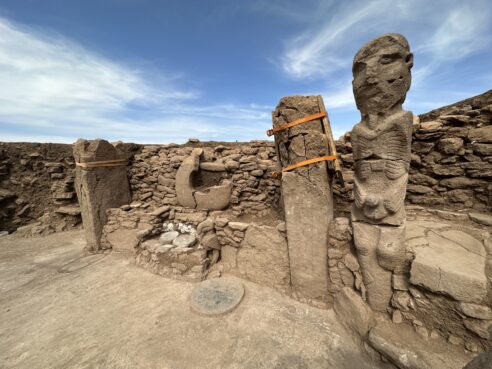Magnificent Discoveries at Karahantepe and Göbeklitepe: Largest Human Statue and First Painted Animal Statue
19 October 2023New findings have come to light in Göbeklitepe and Karahante, one of the world’s oldest Neolithic sites. Human and animal sculptures were discovered during the latest excavations carried out in nine archaeological sites as part of the Taş Tepeler (Stone Mounds) project, which sheds light on prehistory and has led to significant discoveries on a global scale.
Human Statue: An Impressive Example of Prehistoric Art
In the recent excavations at Karahantepe, the largest known human statue of the period was also unearthed. The 2.45-metre-tall statue, which is a candidate to be one of the most impressive examples of prehistoric art with a realistic facial expression, was securely fixed to the ground on a bench. The male figure statue in a seated position evokes a deceased person with emphasised rib, spine, and shoulder bones; on the other hand, the string position of the figure indicates a live person. In the same area, there is a vulture sculpture placed on the front of t the bench where stone plates left on it were also discovered.
The boar in Göbeklitepe: the first painted life-size statue
During the excavations conducted by the Ministry of Culture and Tourism, a life-size wild boar statue made of limestone was found in the D structure of Göbeklitepe. The sculpture, which shows red, white, and black pigment residues on its surface, is the first painted life-size example found from its period to the present day. The wild boar sculpture discovered in Göbeklitepe was found on a bench adorned with decorations, an H-shaped symbol, a crescent, two snakes, and three human faces or masks.
Göbeklitepe: Site that Changed Course of History
Located approximately 18 kilometres northeast of the Şanlıurfa city centre, near the village of Örencik, Göbeklitepe is one of the most significant legacies of human history. As Türkiye’s 18th entry on the UNESCO World Heritage List, this archaeological site has substantially altered our understanding of hunter-gatherer societies, such as the Neolithic Age. The first excavation efforts at Göbeklitepe began in 1995, and numerous findings were unearthed in a short period, including T-shaped pillars adorned with animal motifs and geometric shapes, various human and animal sculptures, stone and bone tools, as well as remnants such as plant and animal bones that reflect the dietary economy of the era. The work at Göbeklitepe has provided significant insights into how settled and productive lifestyles, one of the most significant transformations in human history, emerged. It has also revealed a wealth of new information about social life, architecture, and art during this period, highlighting the existence of a highly developed society in the early stages of the Neolithic Age.
Taş Tepeler: The Land of Great Transformation
In Türkiye, which has long been the land of ancient civilisations, numerous archaeological excavations and restoration projects are carried out in historic areas to ensure the sustainability of cultural heritage. The country currently leads the world in terms of the most archaeological projects. The number of archaeological excavations and studies in Türkiye is expected to reach 750 by the end of 2023.
Archaeological excavations in the country are journeys through time, revealing past stories and connecting us to the human heritage. Studies of contemporary sites in a particular region provide a more holistic understanding of past stories. One such recent project is the Taş Tepeler. The scope of the project at the region carried out under the leadership of Professor Necmi Karul – faculty head of the Department of Prehistoric Archaeology at İstanbul University, has understand the technological, ecological and social aspects of the first settled human societies. Surface surveys conducted in the Şanlıurfa Plateau have led to the discovery of contemporary settlements close to Göbeklitepe. These settlements, collectively referred to as Taş Tepeler (Stone Mounds), include Karahantepe, Sayburç, Sefertepe, Harbetsuvan Tepesi, Gürcütepe, Çakmaktepe, Medik, Kurttepesi, Taşlıtepe, Ayanlar, Yoğunburç and Yeni Mahalle, in addition to Göbeklitepe. Within the scope of the project, which hosts some of the world’s earliest examples of settled life and social complexity, research is ongoing in nine archaeological sites. The excavations at Karahantepe have revealed monumental structures similar to those at Göbeklitepe. The sites continue contributing by archaeological research to shedding light on the human history.

